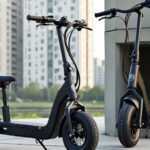Sustainable urban mobility solutions are changing how we move in cities by focusing on eco-friendly and innovative transport. As global populations rise and urban areas expand, there’s an urgent need to reduce car dependency and accept greener options.
Sustainable urban mobility solutions focus on:
- Reducing pollution – Less reliance on fossil fuels through electric and alternative fuel vehicles.
- Decreasing congestion – Employing smart technology for efficient traffic and public transport systems.
- Increasing accessibility – Enhancing the infrastructure for pedestrians and cyclists.
- Encouraging shared mobility – Car-sharing, bike-sharing, and other collaborative transport means.
Cities worldwide are rising to the challenge with strategic innovations, from bike-sharing schemes to changing roadways for pedestrians. But the real driving force behind these changes is the community’s commitment to reducing their carbon footprint and embracing a sustainable future.

Key sustainable urban mobility solutions vocabulary:
Understanding Sustainable Urban Mobility Solutions
Sustainable urban mobility solutions are all about creating a transportation system that is eco-friendly, efficient, and accessible for everyone. These solutions focus on three main areas: low-impact transport, public transport, and active mobility.
Low-Impact Transport
Low-impact transport is about reducing the environmental footprint of how we get around. This means using vehicles that emit less pollution and consume less energy. Electric vehicles (EVs) are a great example. They produce zero emissions at the tailpipe, which helps improve air quality in our cities. Cities like Amsterdam are leading the way by integrating electric bikes and scooters into their transport systems, making it easier for residents to choose greener options.
Public Transport
Public transport is a backbone of sustainable urban mobility. It moves large numbers of people efficiently and can significantly reduce the number of private cars on the road. Cities like Stockholm and Cologne are using smart traffic management systems to optimize public transport routes and schedules. These systems provide real-time information to commuters, helping them choose the best travel options and reducing congestion.
Moreover, expanding public transport options to suburban and rural areas can further decrease car dependency. This is vital as urban areas grow and more people live outside city centers but still need access to urban jobs and services.
Active Mobility
Active mobility focuses on human-powered transport like walking and cycling. It’s not only environmentally friendly but also promotes healthier lifestyles. Cities like Paris are investing in pedestrian and cycling infrastructure by adding bike lanes and expanding pedestrian zones. The concept of the “15-minute city” is gaining traction, where everything you need is within a 15-minute walk or bike ride. This approach encourages people to leave their cars at home, reducing traffic and pollution.

Active mobility also involves making streets safer for all users. This means designing streets that are welcoming to pedestrians, cyclists, and those using mobility aids, ensuring everyone can move around safely and comfortably.
By focusing on these areas, cities can develop sustainable urban mobility solutions that not only address environmental concerns but also improve quality of life for their residents. As we continue to innovate and adapt, these solutions will play a crucial role in shaping the future of urban transport.
Key Trends Shaping Urban Mobility
The way we move around cities is changing fast. Three major trends are driving these changes: increasing traffic volumes, the rise of shared mobility, and the growth of electric vehicles.
Traffic Volumes on the Rise
More people are moving to cities, and with them comes more traffic. According to the OECD, the demand for urban passenger transport is expected to double by 2050. This surge is partly due to the e-commerce boom, which has led to more delivery vehicles on the road.
What does this mean for urban mobility? Cities need to rethink their infrastructure to handle more vehicles. This might include prioritizing road safety and accommodating new forms of delivery, like e-scooters and electric bikes.
Shared Mobility Takes Center Stage
Shared mobility is changing how we get around. Services like carsharing, bike-sharing, and ride-hailing are becoming more popular. By 2030, spending on shared mobility services could reach $500 billion to $1 trillion. This shift is partly driven by consumer preferences and technological advancements.
However, shared mobility can also lead to more congestion. More fleets of shared vehicles mean more space is needed for parking and charging stations. Cities must balance these needs while encouraging shared mobility as a sustainable option.
Electric Vehicles: The Future is Electric
Electric vehicles (EVs) are becoming mainstream. They’re cleaner and more efficient than traditional cars. With regulations pushing for zero-emission vehicles, like California’s mandate for all new cars to be zero emissions by 2035, the shift to electric is accelerating.
EVs are essential for reducing transportation emissions, which account for a significant portion of global CO2 emissions. However, to support this transition, cities need to invest in electric vehicle charging infrastructure.

These trends are reshaping urban mobility. Cities that accept them can create a more sustainable and livable environment for everyone. These changes will guide how we design our cities and transport systems.
Innovative Solutions for Sustainable Urban Mobility
Urban areas face a growing challenge: how to move people and goods efficiently while minimizing environmental impact. Thankfully, sustainable urban mobility solutions are paving the way forward. Let’s explore three key innovations making a difference: smart traffic management, alternative fuels, and mobility hubs.
Smart Traffic Management
Cities like Cologne and Stockholm are leading the way with smart traffic management systems. These systems use sensors to monitor traffic patterns, providing real-time information to commuters. This approach helps reduce congestion and cut down on pollution. When drivers know the best routes and times to travel, they can avoid traffic jams, saving time and fuel.
One study found that smart traffic systems can reduce travel times by up to 66%. They also help lower accident rates and fuel consumption, making cities safer and more efficient places to live.
Alternative Fuels
Transitioning from fossil fuels to alternative fuels is crucial for sustainability. Electric vehicles (EVs) and hydrogen-powered vehicles are two promising options. EVs are particularly popular, with cities investing in charging infrastructure to support their growth. For example, GrowSmarter has implemented charging points to encourage the use of alternative fuels.
Hydrogen vehicles, though less common, offer another clean option. They emit only water vapor and can be refueled quickly, making them attractive for long-distance travel.
Mobility Hubs
Mobility hubs are changing how we think about transport. These hubs integrate various modes of transport, like public transit, car-sharing, and bike-sharing, into one convenient location. Amsterdam, for instance, is planning mobility hubs that promote shared mobility options such as electric bikes and scooters.
By connecting different transport modes, mobility hubs make it easier for people to choose sustainable options for their journeys. This reduces the reliance on private cars and helps cut down on emissions and congestion.
These innovative solutions for sustainable urban mobility are helping cities become more livable and environmentally friendly. As we accept these changes, we’ll see a shift towards cleaner, more efficient urban transport systems.
Top 5 Sustainable Urban Mobility Solutions
Smart Traffic Management
Smart traffic management is revolutionizing urban mobility. By using real-time information, cities can significantly reduce congestion. Sensors and IoT devices monitor traffic patterns, offering commuters live updates on the best routes. This not only saves time but also reduces pollution.
In cities like Cologne and Stockholm, these systems have cut travel times by up to 66%. They also decrease accident rates and fuel consumption, making urban areas safer and more efficient.
Alternative Fuel Vehicles
Alternative fuel vehicles are key to a greener future. Electric vehicles (EVs) are leading the charge with their zero-emission engines. Cities are investing in charging stations to support the rise of EVs. For instance, GrowSmarter has boosted charging infrastructure to make EVs more accessible.
Hydrogen-powered vehicles are another promising option. They emit only water vapor and refill quickly, making them ideal for long journeys. Both EVs and hydrogen vehicles play a crucial role in minimizing our reliance on fossil fuels.
Mobility-as-a-Service (MaaS)
Mobility-as-a-Service, or MaaS, integrates various transport services into a single digital platform. This approach makes it easier for users to plan, book, and pay for different modes of transportation. Think of it like a one-stop-shop for getting around the city.
By promoting integrated transport, MaaS reduces the need for private car ownership. It encourages the use of public transit, car-sharing, and bike-sharing, cutting emissions and easing congestion.
Pedestrian and Cycling Infrastructure
Creating pedestrian-friendly cities is essential for sustainable urban mobility. Cities are investing in bike lanes and walkable streets to encourage active mobility. Paris, for example, plans to add 180 kilometers of segregated bicycle lanes to make cycling safer and more appealing.
Walkable communities support public transport and promote healthier lifestyles. By prioritizing pedestrian and cycling infrastructure, cities can reduce the number of cars on the road and improve air quality.
Zero-Emission Urban Logistics
The rise of online shopping has increased the number of delivery trucks in cities, contributing to emissions and traffic hazards. Zero-emission urban logistics aim to tackle this issue with emission-free fleets for last-mile delivery.
Electric trucks and cargo bikes are being used to ensure goods reach their destinations without polluting the environment. This not only helps in reducing urban emissions but also lessens road congestion, making cities cleaner and more livable.
These sustainable urban mobility solutions are reshaping how we move in cities, making them more efficient, livable, and eco-friendly. By embracing these changes, we can build a sustainable future for urban transportation.
Frequently Asked Questions about Sustainable Urban Mobility Solutions
What are sustainable mobility solutions?
Sustainable mobility solutions aim to reduce the environmental impact of transportation. They focus on lowering fuel consumption and promoting ecosystem regeneration. This includes using renewable fuels, like biofuels and electricity, to power vehicles. By shifting away from fossil fuels, we can significantly cut greenhouse gas emissions and improve air quality in urban areas.
How can urban mobility be improved?
Improving urban mobility requires a mix of strategies. Building better bicyclist infrastructure, such as dedicated bike lanes, encourages people to cycle instead of driving. This reduces traffic congestion and emissions.
Carpooling is another effective method. Sharing rides means fewer cars on the road, which saves fuel and cuts down on pollution. Public transportation is also crucial. Expanding city bus routes and commuter trains makes it easier for people to travel without using personal vehicles.
What are examples of sustainable urban mobility?
Electric vehicles are a prime example of sustainable urban mobility. They run on electricity instead of gasoline, producing zero emissions. Cities are investing in EV charging stations to support this shift.
Renewable fuels, like hydrogen, are also making waves. Hydrogen-powered vehicles emit only water vapor, making them a clean alternative to traditional cars.
City buses that use renewable fuels are another example. They provide efficient public transport while reducing the city’s carbon footprint. By integrating these technologies and strategies, cities can create a more sustainable and eco-friendly transportation system.
Conclusion
As we wrap up our exploration of sustainable urban mobility solutions, it’s clear that the path to eco-friendly transportation is both challenging and exciting. At Doot Scoot, we’re committed to being at the forefront of this movement. Our focus on eBikes is just one way we’re contributing to a greener future. eBikes offer a practical and sustainable alternative for urban dwellers, making daily commutes cleaner and more enjoyable.
Community building is at the heart of what we do. We believe that by fostering a community of eBike enthusiasts, we can drive change from the ground up. This community not only shares tips and experiences but also advocates for better cycling infrastructure and policies that support sustainable transport.
By embracing these innovative solutions, we can transform our cities into cleaner, more livable spaces. Together, let’s pave the way for a future where urban mobility is both smart and sustainable.
For more on how Doot Scoot is contributing to eco-friendly transportation, visit our website. Join us in our journey towards a greener tomorrow!










